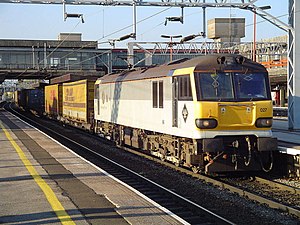British Rail Class 92
British Rail Class 92

|
|
|
|
|
| Performance figures |
| Maximum speed |
87 mph (140 km/h) |
| Power output |
-
25 kV: 6,760 hp (5.04 MW)
-
750 V: 5,360 hp (4.00 MW)
|
| Tractive effort |
- 360 kN (81,000 lbf)
- 400 kN (90,000 lbf) with 'boost' mode applied
|
|
|
|
| Performance figures |
| Maximum speed |
87 mph (140 km/h) |
| Power output |
-
25 kV: 6,760 hp (5.04 MW)
-
750 V: 5,360 hp (4.00 MW)
|
| Tractive effort |
- 360 kN (81,000 lbf)
- 400 kN (90,000 lbf) with 'boost' mode applied
|
The British Rail Class 92 is a dual-voltage electric locomotive which can run on 25 kV AC from overhead wires or 750 V DC from a third rail. It was designed specifically to operate services through the Channel Tunnel between Britain and France. Eurotunnel indicates the Class 92 locomotive as the reference for other locomotives which railway undertakings might want to get certified for usage in the Channel tunnel.
Locomotives of this type are operated by GB Railfreight/Europorte 2 and DB Cargo UK. In France, a number were also owned and operated by SNCF; these were classified as CC 92000 on French railways.
The class 92 was intended as a mixed traffic locomotive for hauling both international freight trains and the ill-fated and never introduced Nightstar passenger sleeper trains though the Channel Tunnel. Since introduction the fleet was exclusively allocated to freight, however, in March 2015 six locomotives owned by GB Railfreight have begun passenger operations hauling the Caledonian Sleeper on behalf of Serco between London and Scotland, marking the very first use of the class in commercial passenger service.
The fleet of 46 locomotives was built by a consortium of Brush Traction and ABB Traction. Parts construction was sub-contracted, with final construction and commissioning being undertaken at Brush's erecting shops at Loughborough between 1993 and 1996 (First unit was produced from 1992, and was finished in April 1993).
...
Wikipedia

